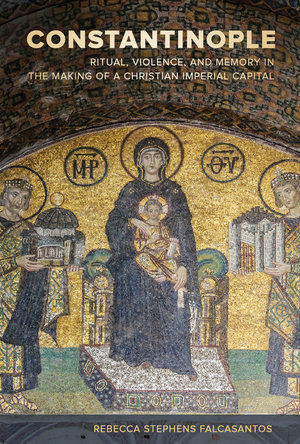By Rebecca Stephens Falcasantos, author of Constantinople: Ritual, Violence, and Memory in the Making of a Christian Imperial Capital
Ritualized occasions—holy days and holidays, funerals and weddings, graduations and retirements, conferences, protests, and elections—are crucial for communities. These events create a sense of connection, help to organize (and reorganize) social hierarchies, and provide spaces to mark out shared values.
The current pandemic has had profound effects on the ritualized actions of our communities. We are consequently experiencing a moment of experimentation, innovation, negotiation, and contestation as we adapt to our new, and hopefully temporary, circumstances. But the moment also highlights fascinating questions for scholars of religion: What makes a successful “COVID-era” ritual? What elements can be reshuffled, what additions or omissions allowed? What changes will persist, and how naturalized will they be? And how do these innovations reinforce, invert, or (perhaps) shatter prevailing social hierarchies?
My book, Constantinople: Ritual, Violence, and Memory in the Making of a Christian Imperial Capital, considers another moment of experimentation, innovation, and change: the reshaping of a newly re-founded and quickly expanding Roman city during the fourth and fifth centuries. This reshaping occurred not simply through reshuffling the rituals of civic life, but also in the ways that people talked about Constantinople, the ways they constructed its spaces, its past, and its rituals.
We can see these negotiations and contestations fairly readily in Constantinople because of its peculiar circumstances. A small city—a town, really—that had only received limited notice before Constantine rededicated it in 337, Constantinople quickly became a dynastic capital for Constantine’s successors during their eastern campaigns. Within a century, it had not only begun to surpass other major cities in the region, but was also hailed as a New Rome and the primary home of the imperial court in the Roman empire’s eastern provinces. These circumstances encouraged heightened competition among the city’s population—a population with a significant number of immigrants belonging to the magisterial, bureaucratic, and intellectual classes who competed for prestige and institutional authority. Add a relatively open landscape in which to plant new monuments, including temples, and Constantinople was an ideal canvas for a group of individuals who had recently gained access to imperial patronage and who were acquiring the social capital to influence cultural institutions. They could, essentially, build a Christian city from the ground up.
Building from the ground up, however, is an illusion—part of the process of naturalizing the results of decades of experimentation and contestation. It is like saying that mail-in votes are not absentee ballots, that adaptation is rupture.
But, as I argue, such changes do not happen outside inherited practices and discourses (except, perhaps, in moments of severe trauma). Ritualized actions—whether modern elections or ancient festival processions—are recognized by and have meaning for their participants because they somehow fit within their participants’ expectations of what rituals should be. Those expectations are formed though previous experience and training, but also shaped and reinforced by discourses of various sorts, from public orations and stories about individuals and places to imperial pronouncements to legal codes. Importantly, these expectations are deep, embodied things.
What my book offers is an exploration of how individuals in Constantinople were able to work within their own inherited cultural system, with its deep ritual habits, assumptions, and hierarchies, to reshuffle its pieces enough that it appeared vastly different within a handful of generations. A driving theme throughout is the importance of the stories that were told: stories about which monuments Constantine built in his new city and to which deity they were dedicated, about which social groups committed acts of violence and why, and about whose cultic rituals gained the favor or disfavor of God. Eventually, these stories came to focus on the orthodoxy of the city and its emperor in a narrative that naturalized a century’s worth of changes by mischaracterizing its experimentation and contestation and demonizing or erasing alternate possibilities.
Constantinople went to press before the pandemic and the challenges it has presented to our communities began to unfold. But these past months have been a constant reminder of how much rituals and ritualized occasions matter—and how much the stories we tell shape the meanings they have for individuals and the groups they identify with.

